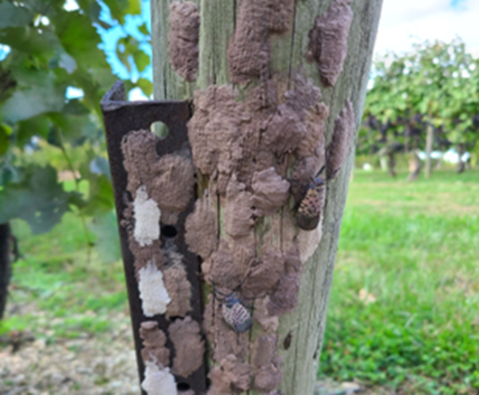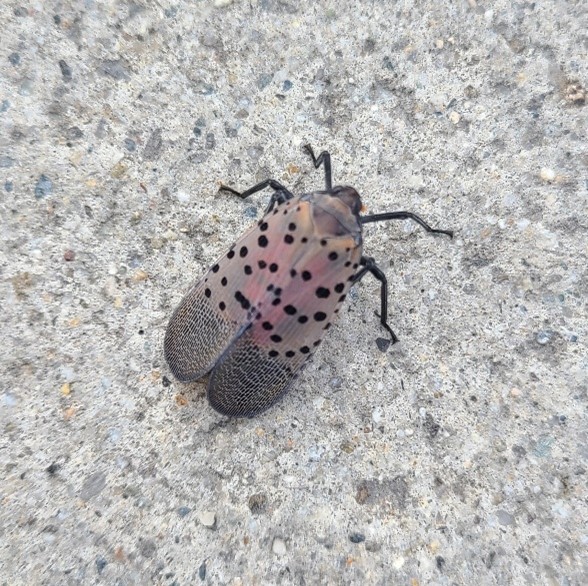
Egg masses and adult spotted lanternfly. Photo courtesy Heather Leach, PSU Extension
Montpelier, VT - While you are out there viewing the quite lovely foliage that shines in the afternoon glow of the Green Mountains, please keep your eye out for another potential multi-colored but unwelcome denizen of the woods, the spotted lanternfly (SLF). This colorful insect is an invasive species, able to take advantage of the lack of natural enemies and proliferate at the expense of our vegetation. One natural enemy that it can’t avoid, no matter how it tries, is our friend Jack Frost. Once the frost is on the pumpkins, the adult SLF will die. A good hard killing frost will knock out the adult population of SLF. However, their eggs can survive temperatures far below freezing and will hatch in the spring, wreaking havoc once again.
Remember, we do not have an established population of SLF in VT, as far as we know. But each year we get reports of hitchhiking SLF coming in from other states, and even though we check as many of these reports as we can, it’s possible that there may be some adult SLF in the state. Ideally, we will get a frost before any of these hitchhiking SLF adults lay eggs. And if you see any form of SLF, please squash or capture it and get a photo. These are a Federally regulated pest, and we need to have a specimen or a photo to take action.

Spotted lanternfly adult. Photo courtesy Jake Wilson.
Where to look for spotted lanternfly:
The preferred host of the invasive insect spotted lanternfly at this time of year is the tree-of-heaven, Ailanthus altissima. This invasive plant species looks a lot like our native staghorn sumac (Rhus typhina). The leaves on each species are different: the edges of tree-of-heaven (TOH) leaves are smooth but staghorn sumac leaf edges are serrated. TOH leaves have two to three glands at their base, but staghorn sumac do not.
Another place to check for SLF is in vineyards. Grapes are a preferred species for SLF and are the crop that sustains the most damage from this insect pest. Massachusetts found more SLF infested counties in 2023 including Berkshire county. If you are a vineyard owner or operator in southern VT, consider taking a look for SLF adults or egg masses on the perimeter of your vineyards.
Looking for eggs is difficult but timely. Each SLF female can lay 30-50 eggs per mass, and they lay up to two masses. The egg masses can be hard to see sometimes but they can be found on almost anything. Just like the spongy moths, when there are a lot of adults they will use any available surface for depositing egg masses. Look on or under your car, on your yard furniture, on walls and on surrounding vegetation. If youtravelled through or from an infested state please note that the egg masses can blend in easily so use a flashlight if you are inspecting your car.
The eggs go through a few color changes before turning into the mud-like grey color that they’ll overwinter in. When the eggs are first laid the female SLF coats them with a substance that looks glossy bright off white in color. This will fade to a pinkish color, then tan, then a mud-like grey which will crack over time. Towards the spring the covering starts to wear off and the eggs may become exposed. In SLF infested states both Federal and State personnel spend their fall and winters scraping SLF egg masses to control their SLF populations. Even though some of the egg masses can be quite high up, removing as many as possible will help to reduce a local population.
A map of reported SLF distribution can be found at https://cals.cornell.edu/new-york-state-integrated-pest-management/outreach-education/whats-bugging-you/spotted-lanternfly/spotted-lanternfly-reported-distribution-map

Spotted lanternfly adult. Photo courtesy Judy Rosovsky
